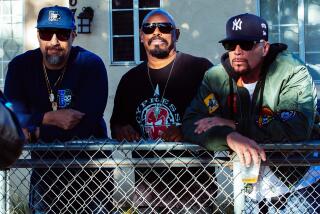Cable’s Disney Channel Features Restored Fred Astaire TV Specials
- Share via
Fred Astaire dances on TV again Sunday--if not exactly live, then very much in living color, with even a few nostalgically amusing commercials for 30-year-old Plymouths and DeSotos thrown in between the late dancer-extraordinaire’s effortless hoofing.
Thanks to the most ambitious and expensive attempt at restoring long-thought-lost, destroyed or decayed videotapes of old television shows, three Astaire TV specials originally broadcast three decades ago will be rebroadcast on the Disney Channel over the next two months.
The first of these specials, “An Evening With Fred Astaire,” which won a then-unprecedented nine Emmy Awards following its original broadcast on NBC in 1958, airs Sunday at 9 p.m. as part of the Disney Channel’s free preview week that will enable any cable viewer to watch the pay channel’s programming without charge.
While film restoration has been a common and valued practice within the motion picture industry for many years, preserving or restoring television programs traditionally has not been viewed with the same kind of urgency. But Robert Rosen, director of the UCLA Film and Television Archive, maintains that preservation of such works of “popular culture” is important “for the same reasons that we have libraries for books and museums for paintings.”
“And we thought the single best case for preservation was to put images on the screen that people fall in love with,” Rosen said, explaining why the UCLA Archive sought out the Astaire tapes for its first TV restoration project. “When you get a sense of what might have been lost, you come away committed to the cause of preservation.”
All three of the acclaimed specials were originally choreographed by Astaire’s longtime collaborator Hermes Pan and the first two were produced and directed by Bud Yorkin. They include solos by Astaire as well as dances with his partner, Barrie Chase, medleys of songs, and musical interludes by the Jonah Jones Quartet and Count Basie.
“More than the movies, the television specials are probably the definitive work of Astaire on screen,” former Times Television Critic Cecil Smith wrote of the TV shows shortly after Astaire’s death in 1987. “It was pure dance.”
But until the UCLA restorers went to work on them, these programs, which archivists say were the first ever to use color videotape to prerecord material for broadcast at a later time, could only be seen in muddy, black-and-white kinescope film transfers or in virtually unwatchable color copies.
Now, after 18 months of intensive preservation work, the results are startling--the visual and sound quality surpassing that of the original broadcast and the programs looking and sounding as good as anything broadcast on television today.
But the technical perfection of the final product belies the rigors of the preservationist’s ordeal. It took four years of searching before UCLA found the original two-inch videotape masters in a vault at MCA-Universal. Before he died, Astaire and his wife, Robyn, also supplied UCLA with a few other tapes of the shows that they had kept in their own personal library.
Though all of these tapes were in surprisingly good condition, archivists could not screen them because the machine used to record and play back the programs in 1958 no longer existed.
“It was something out of another century,” Rosen said. “Like Egyptian hieroglyphics. We had to go out and reinvent the equipment to bring the image alive again.”
Another six months of searching turned up a retired RCA engineer, who found the original circuit design of the video recorder in his den in Pennsylvania. With the help of technicians and equipment at KTLA Channel 5, the restorers redesigned the antiquated recorder and transfered the tapes using the latest video technology to new masters, preserving image and sound exactly as they were recorded in 1958.
Another year of tinkering with the color and sound restored the shades and tones of the costumes, props, faces and voices to their original splendor.
“This is not colorization of black-and-white images,” said Edwin Reitan, UCLA’s “chief magician” on the Astaire restoration. “This is actual color television from 1958, now preserved forever.”
Even the original commercials that aired during the programs have been restored and will be part of the Disney broadcasts.
“I’m shocked and pleased at what UCLA did. It’s amazing to see,” said Barrie Chase, who was only 23 when the 59-year-old Astaire chose her as his dance partner for these specials. “I laugh at the thought of my son seeing his mom as she used to be. And I have a nostalgic sad and happy feeling of the emotion I felt when I was doing it.”
The restored 1959 special, “Another Evening With Fred Astaire,” will air Dec. 18 on the Disney Channel, and “Astaire Time,” first broadcast in 1960, will debut Jan. 8.
“Unlike some legends, which diminish when they’re re-examined, these specials show that Astaire’s artistry is as compelling today as it was 30 years ago,” said Bruce Rider, vice president of programming for the Disney Channel. “For dance fans, the restoration of these treasures will be the television highlight of the winter.
“Our Astaire tribute provides the first opportunity for most people to see the specials as they were produced--in color,” Rider continued. “When they were first presented, most television viewers owned black-and-white sets.”
A representative of MCA-Universal, which owns the distribution rights to these restored specials, said the company is hoping to release them on home video after the Disney Channel broadcasts and is looking into releasing them to broadcast television as well.
Meanwhile, at UCLA, some 80 tapes of speeches and outtakes shot during John F. Kennedy’s 1960 presidential campaign, which marked the first use of mobile video units, are next in line for similar restoration work.
The archive also plans to preserve tapes of the 1958-63 “United States Steel Hour,” “Play of the Week” episodes from 1959-61, a 1966 NBC series called “The Negro in American Culture,” and a bevy of local news and public-affairs programs from the early days of local TV news, including coverage of the Watts riots, Robert Kennedy’s assassination, the 1971 earthquake and the TV-magazine forerunner “Ralph Story’s Los Angeles.”
More to Read
The biggest entertainment stories
Get our big stories about Hollywood, film, television, music, arts, culture and more right in your inbox as soon as they publish.
You may occasionally receive promotional content from the Los Angeles Times.










